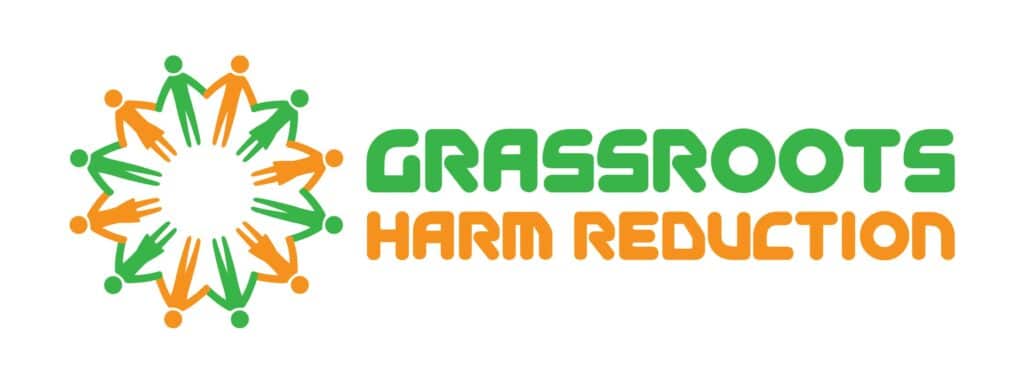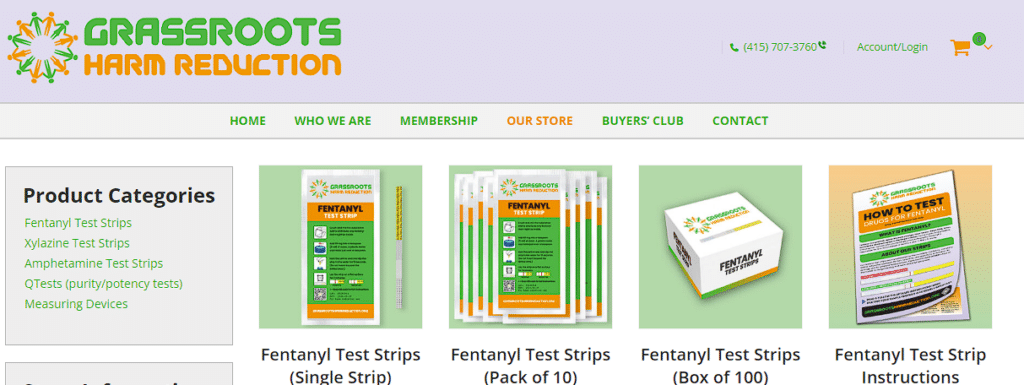Grassroots Harm Reduction is a new network of activists and experts looking to help you bring harm reduction to your community.
For decades, the harm reduction movement has been working to help bring safety to people who use controlled substances. Between the continued war on drugs and a growing opioid crisis, these services are needed now more than ever.
But while you might imagine vulnerable or suffering people when thinking of harm reduction, safe consumption applies to recreational users as well. Harm reduction aims to help keep all drug users healthy and safe, recreational or otherwise.
Working to bring that safety to people who use drugs in your community can seem daunting, but it doesn’t have to be. We connected with Carter Graves, the executive director of the newly founded Grassroots Harm Reduction network, to provide you valuable resources for advocacy.
The owner of KMFK Safety Services, a group in Pittsburg doing harm reduction through community-centered action and peer-led education, Carter personally understands identifying a need in your community and finding ways to fill it through years of experience. It was an honor to speak with Carter about their journey and how it led to the birth of something as needed as the Grassroots Harm Reduction network.
Related: How End Overdose Is Combatting the Opioid epidemic.
Hey Carter, it’s great to chat with you today. Before we dive into Grassroots Harm Reduction, please tell us a little about your background and connection to harm reduction.
Point A would be during the great ecstasy shortage of 2011. A lot of research chemicals came out during that time, and we had noticed that there was a change in the market. Actually, my partner is my origin story. He discovered reagent test kits online, shipped straight to the house.
Through chemical reactions, reagent kits can tell you what you have in your substance. He used that to help the people in my community identify what they were taking and make better consumption choices after he had taken something that left him talking so fast he could no longer talk at all. He was communicating through an iPad and it was scary. We later found out it was something called Formac. It brought back a childhood stutter that he still has today.
So we started engaging in harm reduction for personal use and by word of mouth within my community. And in — sorry, it’s always a tough story to tell — seeing the lasting effects of something like that. Because of that, I was seen as inherently safe. People would come up to me and they’d be like, “Hey, do you have this on you? Can you come test my stuff?” And that led to me being a harm reduction-forward security service.
We call ourselves an onsite health and safety team now as an abolitionist take to serving the community, as we don’t want to act like an occupying force in the communities that we love. That led to the creation of KMFK Safety Services, an onsite health and safety service that focuses on consumption consent and helping people learn how to consent to the things with which they are engaging. I started that in 2021 and we have rocketed ever since.
With that, I got the notice of an electronic music safety-centered harm reduction group called DanceSafe. They asked me to help get their chapter back in shape, and from helping get the local chapter back on its feet, I connected with a broader harm reduction community. They loved my unconventional approach to servicing our communities, and that broader introduction brought me to places like the PA Harm Reduction Network, getting national notoriety, and connecting with grassroots harm reductionists across the US who were similar to myself.
I’ve done this all out of my own pocket with no help. KMFK Safety Services is not an org, we’re an LLC that operates like a nonprofit but through self-funding. So we’re very passionate about direct, community-centered action. So, I went from personal harm to executive director of Grassroots Harm Reduction Network.

What has been the driving force behind forming Grassroots Harm Reduction?
Looking for a way to bridge the gap between people who are driven to service their community, and what it costs to service the community. For myself, starting out, Fentanyl test strips alone were $300 a month. A lot of the comments I was getting were “become an org, you’ll get funding,” stuff like that. That didn’t fit the mold for how I envisioned for myself doing this work, nor would it meet the needs of my community in the unique way that they needed to be met.
So, Grassroots Harm Reduction is bridging that, to be able to correct that harm that I experienced, that my friends have experienced. Like Wicked Clown Harm Reduction in Columbus or Stabbin Wagon in Medford, Oregon, where we don’t have funds and we don’t have the skills nor the want to be orgs, but we still want to service our peers, our loved ones, those living outside, and recreational drug users, or even just ourselves.
Grassroots Harm Reduction hopes to be able to fill those gaps in services in a way that helps you service your peers the ways they need to be serviced.
What’s the core mission and how is this different from other organizations operating today?
I mean, every org has their thing in a way. We all service different niches because we all were born out of helping our community and wanting to spread that. So, in a sense, we are a lot like other orgs, but different from other orgs because of our way of adapting and providing services that center local groups.
Our core mission and our core values are being focused, grateful, and operating with integrity and ethics. We are service hearted, passionate, and want to center people who use drugs as well as their communities. We aim to build and strive for solidarity between all people who use drugs, and all people who care for people who use drugs.
We understand that all the founding members were affiliated with DanceSafe, and their founder is even an advisor. Aside from DanceSafe, what brought you all together?
A lot of it is common cause, we all have the same lived experiences to a certain degree. We want to be community focused and have that drive to create compassionate systems — not just compassion for one another, but compassionate systems — and systemic change.
So those common causes are what we have in common, more so than a lot of us originating with DanceSafe. DanceSafe was the connective tissue for this and I’m very grateful for that stepping stone, but we have so much more in common than just DanceSafe. It’s our passion.

Often, when people work in harm reduction, what motivates their direct action is that passion and that desire to help their community in any way. Now, you’re here and you’re saying that every community is different, and we all may not know the nuances of servicing each other’s communities but we can provide support and resources. It’s cool to see that you all are creating something that helps all these hubs to coexist, have support, and support each other.
It was something I greatly needed when I was starting out as an individual. A lot of the people I meet are BIPOC, disabled, disenfranchised, and/or living in extreme poverty and still looking to serve. At that core, we want to support people who want to do that because there are so many holes, obstacles, and barriers that people experience with that compounding pain. So, if we can help through affordable prices and one-on-one peer support — I mean, I’m full of tips and tricks. I will sit one on one with somebody all day and be like, “What are your needs? Let me see if I can help you find a creative solution.” I’m not here to fix anything for anybody. I’m helping them help others.
Touching on that, what do you think is most lacking in harm reduction space today? Is Grassroots Harm Reduction aiming to fill this void? Investigate it? Learn more? Uncover it?
I think inherently working in harm reduction is all those things, is it not? That’s part of the activism that comes from these people. We’re just trying to shake up the system.
The thing that, in my opinion, is most lacking, is that we’re losing that drive to actually abolish the drug war, and a lot of band-aids are coming up. Granted, we are one of those band-aids to the issue, but instead of supporting the small guy doing the work and keep people alive until organizations that focus on policy can get the policy changed — why not break down that barrier for now?
So, I would like to say that’s what sets us apart from other orgs, breaking down barriers in the ways that grassroots activists are asking for them to be broken down. Not just, “Hey, we’re assuming this will be helpful for your state.” No, let me reach out to you and say, “What is helpful for you in Lancaster, Pennsylvania? What is helpful for you on the outskirts of Kensington?”
In Pennsylvania, so much of the focus is on Xylazine and opiate use that we’re overshadowing recreational drug users. They’re so left out of the conversation. We’re not just here to focus on Fentanyl and Xylazine. We’re here to focus on what you’re focused on, and I think that sets us apart from other groups.

Tell us a little about the member organizations. Are they all going to be focused on the music and festival space?
Member orgs can engage with us for needs-based pricing and peer-to-peer support. So, they reach out, we work one on one with them to be like, “Hey, what are your needs? Okay, here’s how we can help. Do you have feedback? How can we improve?” and connect them with local resources.
They do not have to be orgs, I want to be specific about that. Org is just a term people understand. You can be an individual who’s looking to fill a backpack full of supplies or do something out of your hatchback. You will be able to reach out to a direct line and get support for that.
We will not be focused on music. Our focus is on what your focus is on. So, if you’re looking to help the homeless population who’s living on a greenway, how can I help you get started doing that? If you’re noticing it while driving by every day on the highway, and you want to engage with that community, here’s some tips and tricks.
If you want to focus on the music community, you are free to do that, but we are here for anyone who is seeking to better the lives of people who use drugs, whether it’s themselves or their community at home.
How will the member organizations benefit from working with Grassroots Harm Reduction?
There’s plenty of benefits. If I could circle back to KMFK for a moment, I didn’t know who to ask when I started doing this. I didn’t know harm reduction was a thing from 2011 until 2021 when I decided that I was just going to show up with reagent kits and Fentanyl test strips and talk to as many people as possible. Then, I found out a syringe service exchange existed in Pittsburgh.
I think Prevention Point Pittsburgh is the second longest-running needle exchange in the United States. I had no idea. So, to be able to reach out to someone who was like, “Hey, have you thought of this? Can we offer you supplies for this? Is this of benefit to you?” absolutely changed who I was as a harm reductionist. I hope that we can offer that same transformative and supportive experience that Prevention Point Pittsburgh gave me as an individual to member orgs that join us.
By the way, KMFK is now 11 groups deep of solidarity, and we cross-share our volunteers. We were able to build out a network simply because I, as an individual, could reach out to an org that was willing to help me help my community. Grassroots Harm Reduction is looking to build that across the nation.
Is there anything that you want to say to the EDM community about Grassroots Harm Reduction? Any ways that you want to inspire them to help their communities, either inside or outside of dance music?
Honestly, just do the thing. I’m happy to help you do the thing because I think all of us see what’s going on around us. All of us have lost somebody. All of us have been negatively impacted by the war on drugs in one way or another.
To the EDM community, to the recreational users, to those living on the street, help each other and build solidarity. That’s what I have to say to the EDM community. Please just reach out to us, we are ready to start having a positive impact and foster positive outcomes for people who use drugs.
And whether you listen to EDM or not, that resonates with a lot of people. So, reach out to us. We’ll fill your backpack up full of Fentanyl test strips and show you how to get out there.








